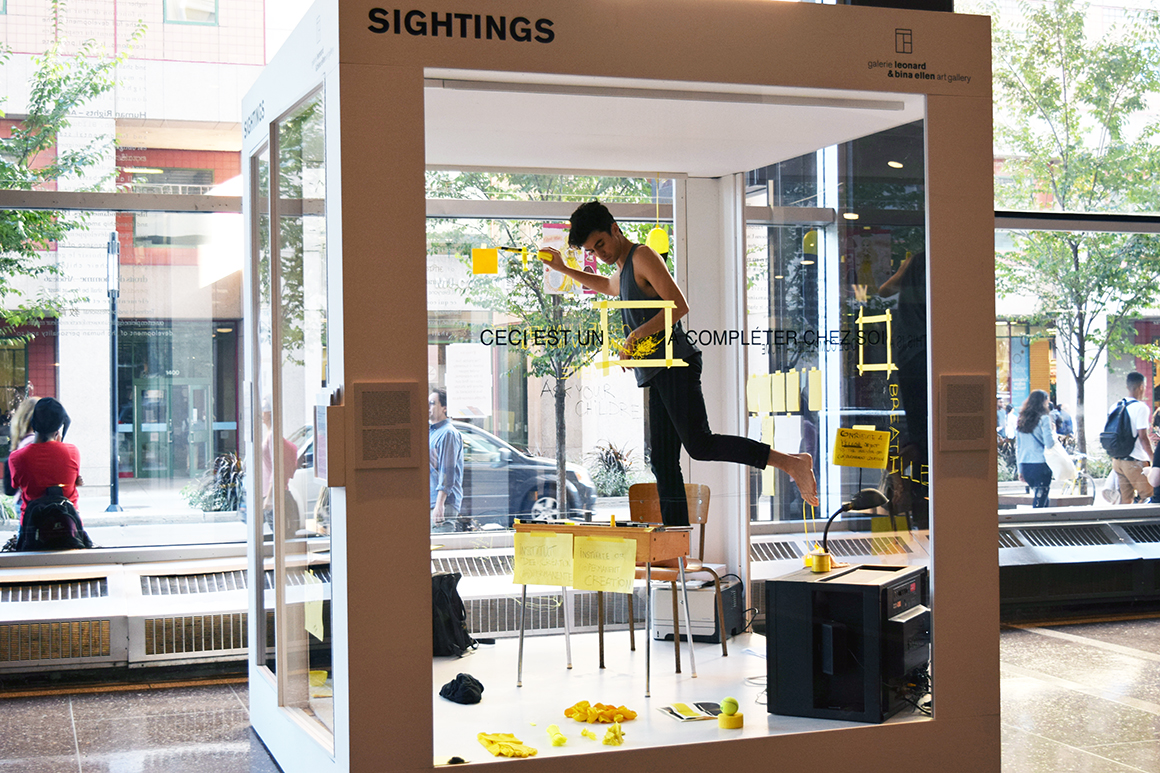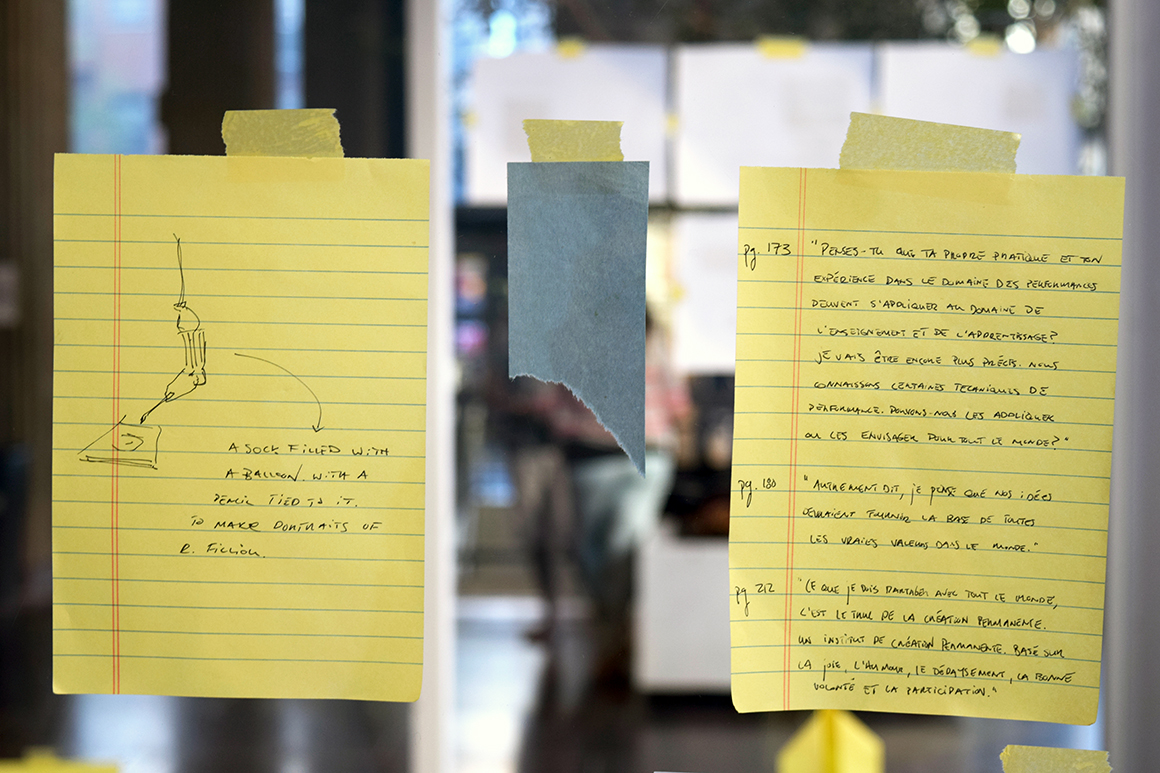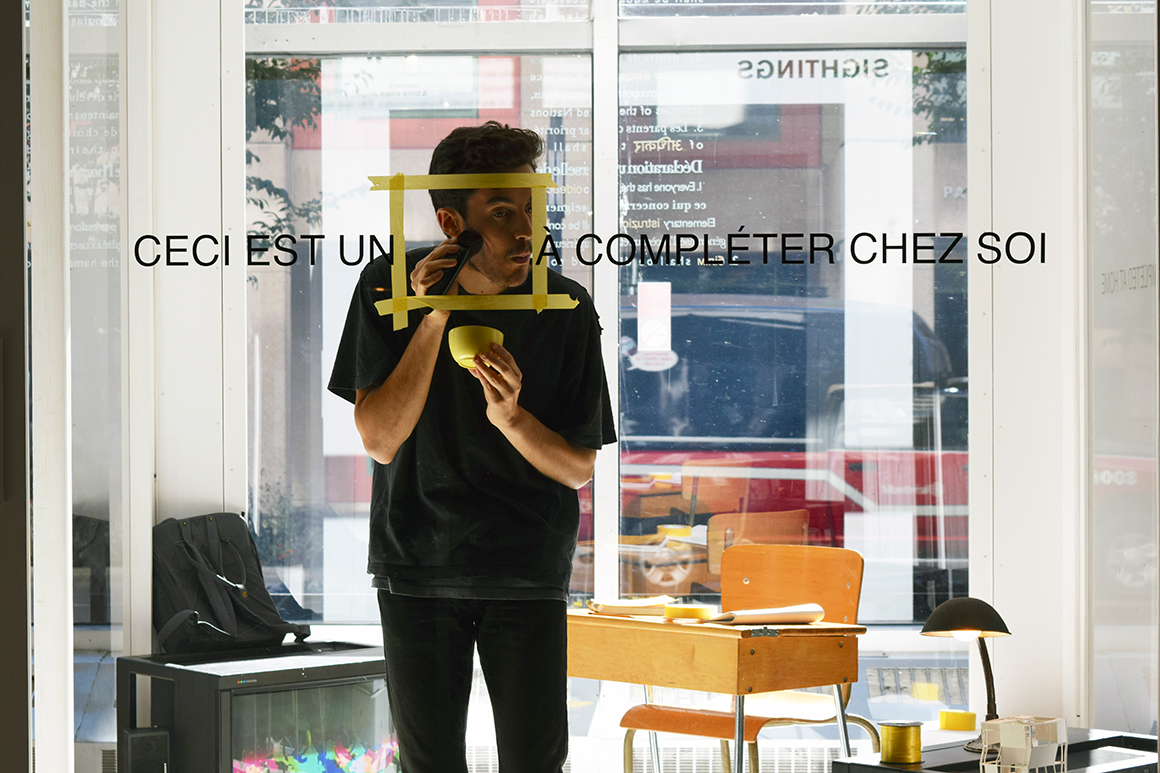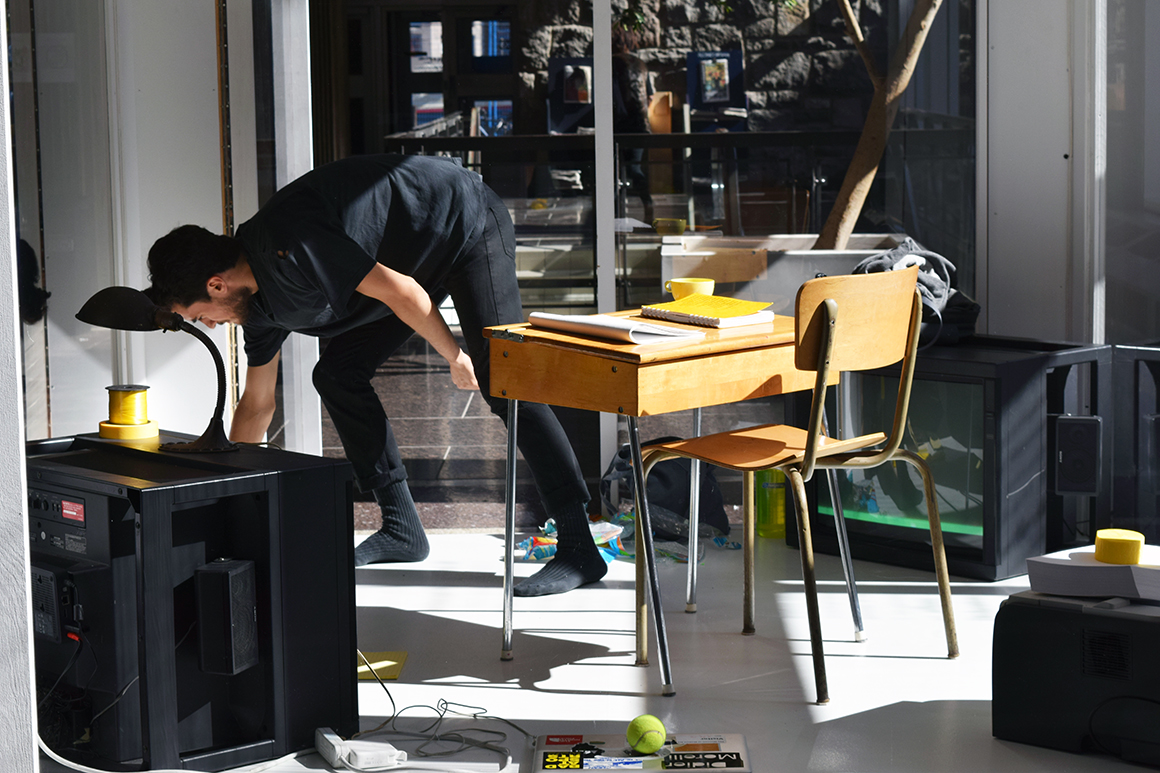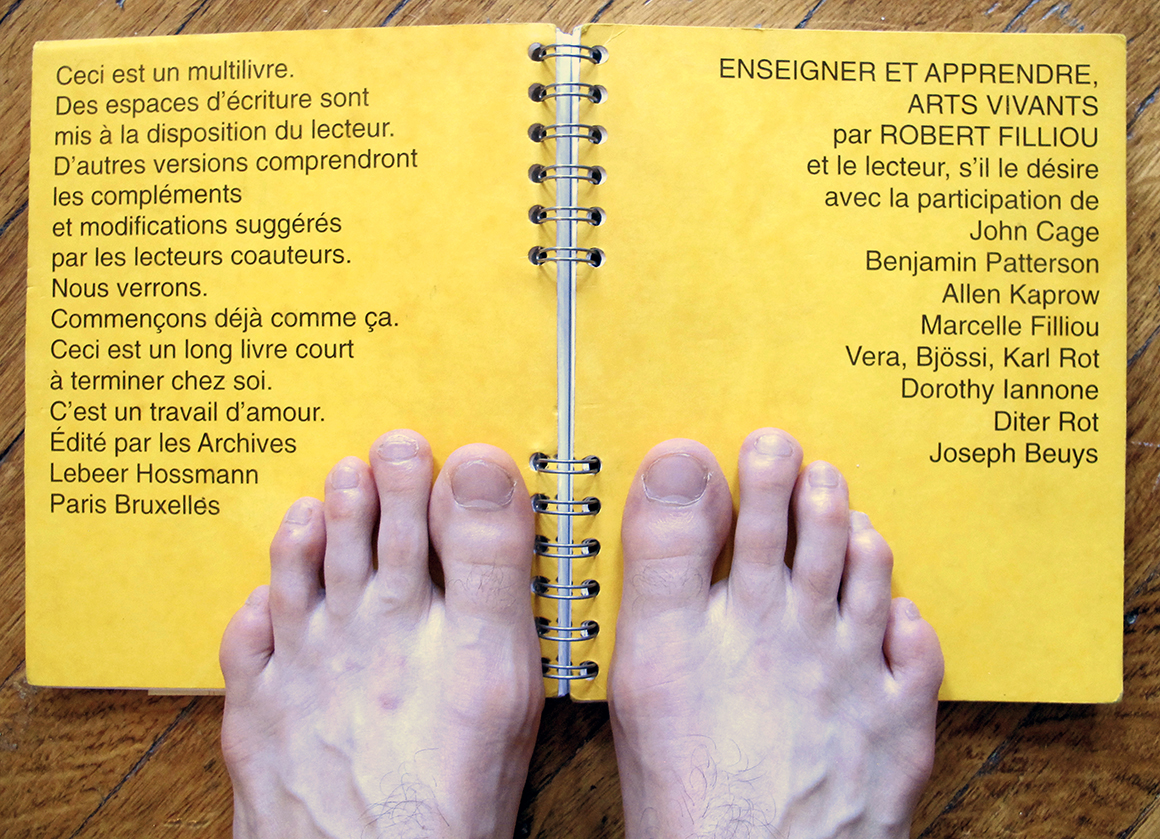Launched in 2012 in celebration of the 50th anniversary of the Leonard & Bina Ellen Art Gallery’s Permanent Collection, the SIGHTINGS satellite exhibition program was conceived as an experimental platform to critically reflect upon the possibilities and limitations of the modernist “white cube.”
In 2015, the Gallery introduced a new yearly thematic program for SIGHTINGS. Following a first cycle of projects focused on the question of work/labour, the 2016-2017 edition addresses pedagogy, considered as a critical interface between the university, arts venues and social space. With this in mind, artists and curators are invited to use the spatial and conceptual structure of the SIGHTINGS cube to question the construction of knowledge inside and outside the academic “box.”
SIGHTINGS is located on the ground floor of the Hall Building at 1455 De Maisonneuve Blvd. West.
September 12 – November 12, 2016
A project by Maude Johnson and Didier Morelli
A satellite site of the exhibition, located on the 5th floor of the Webster Library (passage area, south side), displays a consultation copy of the book Teaching and Learning as Performing Arts (1970) and presents the video Teaching and Learning as Performing Arts Part II: Travelin’ Light – It’s a Dance, Really (1979), courtesy of the Western Front (Vancouver).
The two collaborators used a Google Drive file to inform and share their research in real time. This file is accessible here.
Contribution to the Institute of (im)Permanent Creation
Tuesday, September 13, 2016, 5 – 8 pm
The public is invited during this event to donate a yellow object of his/her choice, which will be used by the artist during his performance and integrated within the subsequent installation. Yellow refers to the colour of the cover of the book Teaching and Learning as Performing Arts (1970), on which Morelli’s project is based. Referring to Filliou’s methodology, this collaborative process aims to create an ephemeral collection of miscellaneous objects that will serve as entry points to various learning situations.
Promenade
Wednesday, September 21, 2016, 4:30 pm
Maude Johnson, curator of the project, leads a tour linking the SIGHTINGS cube to different satellite sites on campus from which Morelli and her developed their research around the work of Filliou.
Promenades are routes that link the Leonard & Bina Ellen Art Gallery, located in the McConnell Building, and the SIGHTINGS exhibition cube in the Hall Building. Open and variable in length, this activity is an opportinuty for the public to meet the participants of SIGHTINGS, discuss the project on display and reflect in situ on the various issues it raises.
Each Promenade begins at one of the two sites and follows a route determined according to the project and its participants.
The modalities of pedagogy and knowledge transmission raise issues that define and structure the work policies in learning systems. Periodically re-evaluated, these modalities notably attest to the political, economical and social contexts according to which they fluctuate. They are indicative of the paradigms of the moment, but also of the alternatives that seek to deconstruct certain dominant models. There are many artistic practices, both historical and current, that take up this problem of transmission to give rise to new processes of working.
The exhibition Ceci est un ▢ à compléter chez soi : This is a ▢ to be completed at home presents Didier Morelli’s performative research based on the work Teaching and Learning as Performing Arts by French Fluxus artist and economist, Robert Filliou. Since this work takes on many forms and variations, Morelli focused on the eponymous original publication from 1970 and a video recording produced in 1979 as part of a performance at the artist-run centre Western Front in Vancouver. In the fall of 1980 the video was shown at Véhicule Art Inc. in Montreal. After the dissolution of the Montreal artist-run centre in 1983 its archival fonds were acquired by Concordia University. More recently, the university appropriated the history of the centre, incorporating it into its promotional material in the form of panels underlining the link between the foundation of Véhicule Art and Concordia University in the area around the EV building on Guy Street. Based on the idea of an alternative pedagogy via the performative act, Filliou’s work thus returns to the institution.
Read moreIn probing the specific contexts of which it is part, the exhibition seeks to reflect in praxis on the economy of learning, the historical implication of the various potentialities of the performative strategy put forth in Teaching and Learning as Performing Arts and in their articulation (even influence) in contemporary situations. In revisiting this body of work, the permeable borders of artistic work and the malleable structure of these “immaterial activities” are brought into view.
The dialogue that emerges between Morelli’s and Filliou’s practices brings a generation gap and a contextual divergence into play, in addition to the filial relationship. While receiving live information from the curator, who pursues the research in other university sites, Morelli initially carries out a selection, followed by a translation from the written to the corporeal and from the corporeal to the material. This situated research has a life that is independent of the result: its existence is made visible through the physicality of manipulation.
In examining a work that mobilizes a utopian condition that is evocative of a particular historical moment, this project intends to grasp what is essential in the contemporary challenge of pedagogy via performance. Through the immediateness of the unfolding research process and the accumulation that is vital to it—sometimes incoherent and disordered, sometimes arbitrary and partial—Morelli’s durational performance produces knowledge by generating and transmitting information. Considered in their duration action and inaction communicate and translate, constituting together an exercise in transference.
The institutionalization of Filliou’s project is both exhibited and performed in the SIGHTINGS cube, which becomes a space with multiple roles: a site for satellite research, production/representation, and contemporary art display. In an interdisciplinary context where knowledge transmission is increasingly specialized, this critical inquiry seeks to broaden the policies that guide pedagogical strategies used within learning situations linked to the performing arts, where its “transmitting bodies” are defined according to convoluted professional identities. Through this “working studio” approach the exhibition dissects a complex work and embodies its legacy—the showcase is in and of itself performative. The mechanisms of artistic labour are revealed, and, in turn, amplified.
Maude Johnson
CloseDidier Morelli (1989) lives in Chicago where he is a doctoral candidate in Performance Studies at Northwestern University. A multidisciplinary artist who holds a BA from Concordia University (Western Society and Culture), a MA from University of Toronto (Theatre and Performance Studies), and a second MA from Simon Fraser University (Contemporary Arts), Morelli is completing a rigorous academic path. His recent projects include Erase Everything: Geoff Hendricks (1964) (Block Museum of Art, Northwestern University, 2016) and The City In Between (Defibrillator Performance Art Gallery, Chicago, 2015), he also participated in the 2016 Encuentro edition (Hemispheric Institute, Chili, 2016). His practice, which combines performance and academic research, is mostly made up of actions. A practice that involves duration, repetition and endurance is at the heart of a reflection on the apprehension (and, ultimately, the prehension) of time. Morelli seeks to reconfigure our understanding and everyday use of space by focusing on corporality, and more precisely his own body, as a central issue, catalyzer and site of artistic exploration.
Maude Johnson (1988) lives in Montreal where she is a MA candidate in Art History at Concordia University. She holds a BA from Université du Québec à Montréal (Art History). Her research examines the relationship between the body and space, notably through an exploration of performance practices, the archive and new media in the varying contexts of contemporary art. As a writer she collaborated with the exhibition do it Montréal (Galerie de l’UQAM) and contributes to the magazine esse arts + opinions.
Robert Filliou (1926-1987) was a French artist, poet, and economist. Through his work he sought to merge art and life by exploring language as a form and a constituent issue. Filliou’s utopian work radically incorporates daily life as a structuring space for creation. He joined the communist resistance in 1943, left for the United States in 1947 and received a master’s degree in economy from the University of California in Los Angeles (UCLA). Following the completion of his studies, he worked as an economist in Korea from 1952 to 1954, and then lived in Egypt and Spain before settling in Denmark in 1957. Filliou discovered the artistic avant-garde through Daniel Spoerri, whom he met in Paris in 1959. Since the early 60’s, he closely collaborated with Emmett William, a coordinator of the Fluxus movement. Between 1965 and 1968, in Villefranche-sur-mer, Filliou ran with George Brecht La Cédille qui sourit, a boutique and workshop, or a “centre for permanent creation,” as they named it. It was during this time that the two artists developed the concept of “Eternal Network” (in French: “La Fête Permanente”), which heightened the desire for gathering and continuity at the heart of Filliou’s practice. His book Teaching and Learning as Performing Arts was published in 1970 in collaboration with many other artists, including Joseph Beuys, John Cage, and Allan Kaprow.







